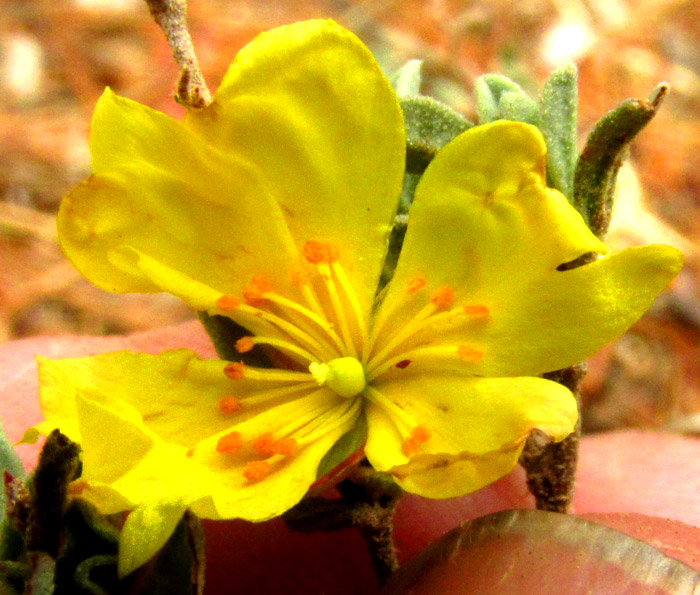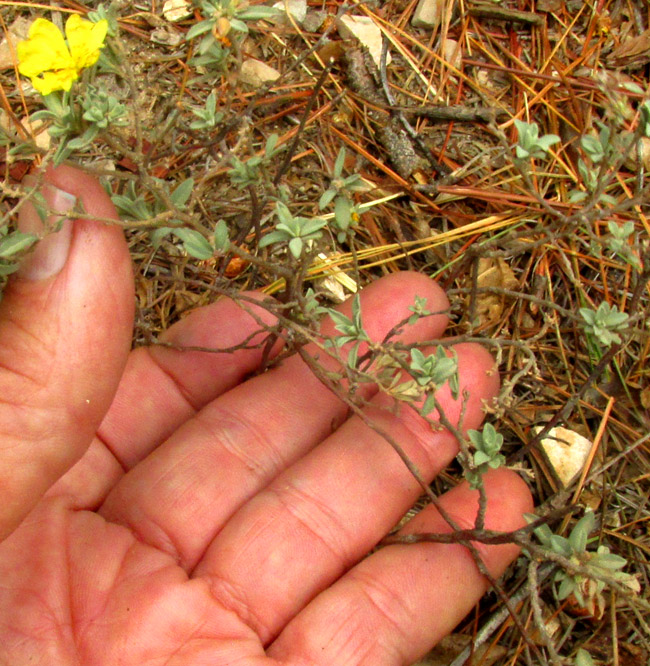Excerpts from Jim Conrad's
Naturalist Newsletter
Entry dated April 21, 2024, from notes taken about 1.5km north of La Cañada, slope above small branch road off Hwy. 120, Municipality of Pinal de Amoles; N21.125°, W99.667°, elevation ~2780 meters (~9120 feet); oak-pine forest on limestone bedrock; in the Eastern Sierra Madre Mountains of east-central Querétaro state, MÉXICO
HELIANTHEMUM COULTERI

Beside a trail up a steep, eroded slope, a single penny-sized fleck of yellowness amid all the scrub, dirt and exposed rock turned out to be the above blossom. Note how the flower's several stamens slightly tend to gather in small clusters. Certain stamen filaments may be united at their bases.

The blossom arose atop a very short pedicel originating amid a cluster of leaves. Note the dense, short-hairy, ashy-looking cover of branched or stellate hairs on the leaves and stems.

For identification to species level, it's useful to notice that leaf undersides and their top surfaces were of the same grayish hue. Secondary veins were not visible branching from the thick, low midrib,and blade tips were rounded to vaguely pointed.

Above, it's seen that the plant was a small shrub, a subshrub, with slender but stiff-woody stems. Moreover, the stems tended to extend outward, keeping low near the ground. Importantly, no clusters of flowers or unopened blossoms are visible along the stems.
The flower was practically identical to what we've seen on the Clustered Frostweed, Crocanthemum glomeratum. However, the lack of flower clusters along the stem, blossom pedicel length, habitat, and its geographical location were different. If this plant wasn't another Clustered Frostweed, surely it was very closely related.
Based on the above features -- especially the lack of Clustered Frostweed's clustered flowers and our blossom's very short pedicels -- I think this must be HELIANTHEMUM COULTERI. Helianthemum coulteri is known by no English name; it occurs somewhat spottily in Mexico's central uplands, south into Nicaragua.
I'm surprised that the Clustered Frostweed has been transferred from the same genus as our Helianthemum coulteri -- earlier it was Helianthemum glomeratum, not Crocanthemum glomeratum -- while our plant remains a Helianthemum. Apparently recent genetic studies show that the two taxa aren't as closely related as they seem.
Though Helianthemum coulteri appears on numerous plant lists, I find no documented uses for the taxon. However, the 2023 work by Soumia Mouffouk and others entitled "Medicinal, Pharmacological and Biochemical Progress on the Study of Genus Helianthemum: A Review," says this about Helianthemum species in general: "Helianthemum plants have antioxidant, antimicrobial, anti-inflammatory, analgesic, antidiabetic, insecticide, anticancer, antiulcer, larvicide, chemo, and hepatoprotective activities."